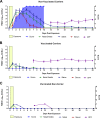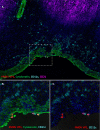Contact Challenge of Cattle with Foot-and-Mouth Disease Virus Validates the Role of the Nasopharyngeal Epithelium as the Site of Primary and Persistent Infection
- PMID: 30541776
- PMCID: PMC6291620
- DOI: 10.1128/mSphere.00493-18
Contact Challenge of Cattle with Foot-and-Mouth Disease Virus Validates the Role of the Nasopharyngeal Epithelium as the Site of Primary and Persistent Infection
Abstract
The pathogenesis of foot-and-mouth disease virus (FMDV) in cattle was investigated through early and late stages of infection by use of an optimized experimental model for controlled contact exposure. Time-limited exposure of cattle to FMDV-infected pigs led to primary FMDV infection of the nasopharyngeal mucosa in both vaccinated and nonvaccinated cattle. In nonvaccinated cattle, the infection generalized rapidly to cause clinical disease, without apparent virus amplification in the lungs prior to establishment of viremia. Vaccinated cattle were protected against clinical disease and viremia; however, all vaccinated cattle were subclinically infected, and persistent infection occurred at similarly high prevalences in both animal cohorts. Infection dynamics in cattle were consistent and synchronous and comparable to those of simulated natural and needle inoculation systems. However, the current experimental model utilizes a natural route of virus exposure and is therefore superior for investigations of disease pathogenesis and host response. Deep sequencing of viruses obtained during early infection of pigs and cattle indicated that virus populations sampled from sites of primary infection were markedly more diverse than viruses from vesicular lesions of cattle, suggesting the occurrence of substantial bottlenecks associated with vesicle formation. These data expand previous knowledge of FMDV pathogenesis in cattle and provide novel insights for validation of inoculation models of bovine FMD studies.IMPORTANCE Foot-and-mouth disease virus (FMDV) is an important livestock pathogen that is often described as the greatest constraint to global trade in animal products. The present study utilized a standardized pig-to-cow contact exposure model to demonstrate that FMDV infection of cattle initiates in the nasopharyngeal mucosa following natural virus exposure. Furthermore, this work confirmed the role of the bovine nasopharyngeal mucosa as the site of persistent FMDV infection in vaccinated and nonvaccinated cattle. The critical output of this study validates previous studies that have used simulated natural inoculation models to characterize FMDV pathogenesis in cattle and emphasizes the importance of continued research of the unique virus-host interactions that occur within the bovine nasopharynx. Specifically, vaccines and biotherapeutic countermeasures designed to prevent nasopharyngeal infection of vaccinated animals could contribute to substantially improved control of FMDV.
Keywords: FMD; FMDV; NGS; cattle; foot-and-mouth disease; foot-and-mouth disease virus; pathogenesis; pigs; transmission; virus.
Copyright © 2018 Stenfeldt et al.
Figures






Similar articles
-
Pathogenesis of virulent and attenuated foot-and-mouth disease virus in cattle.Virol J. 2017 May 2;14(1):89. doi: 10.1186/s12985-017-0758-9. Virol J. 2017. PMID: 28464897 Free PMC article.
-
The Foot-and-Mouth Disease Carrier State Divergence in Cattle.J Virol. 2016 Jun 24;90(14):6344-64. doi: 10.1128/JVI.00388-16. Print 2016 Jul 15. J Virol. 2016. PMID: 27147736 Free PMC article.
-
Pathogenesis of Primary Foot-and-Mouth Disease Virus Infection in the Nasopharynx of Vaccinated and Non-Vaccinated Cattle.PLoS One. 2015 Nov 23;10(11):e0143666. doi: 10.1371/journal.pone.0143666. eCollection 2015. PLoS One. 2015. PMID: 26599543 Free PMC article.
-
The pathogenesis of foot-and-mouth disease virus: current understandings and knowledge gaps.Vet Res. 2025 Jun 16;56(1):119. doi: 10.1186/s13567-025-01545-5. Vet Res. 2025. PMID: 40524230 Free PMC article. Review.
-
Unapparent foot and mouth disease infection (sub-clinical infections and carriers): implications for control.Rev Sci Tech. 2002 Dec;21(3):519-29. doi: 10.20506/rst.21.3.1366. Rev Sci Tech. 2002. PMID: 12523693 Review.
Cited by
-
Mechanisms of Maintenance of Foot-and-Mouth Disease Virus Persistence Inferred From Genes Differentially Expressed in Nasopharyngeal Epithelia of Virus Carriers and Non-carriers.Front Vet Sci. 2020 Jun 19;7:340. doi: 10.3389/fvets.2020.00340. eCollection 2020. Front Vet Sci. 2020. PMID: 32637426 Free PMC article.
-
Estimating viral bottleneck sizes for FMDV transmission within and between hosts and implications for the rate of viral evolution.Interface Focus. 2020 Feb 6;10(1):20190066. doi: 10.1098/rsfs.2019.0066. Epub 2019 Dec 13. Interface Focus. 2020. PMID: 31897294 Free PMC article.
-
Foot-and-Mouth Disease Virus Interserotypic Recombination in Superinfected Carrier Cattle.Pathogens. 2022 Jun 3;11(6):644. doi: 10.3390/pathogens11060644. Pathogens. 2022. PMID: 35745498 Free PMC article.
-
Multiple Genomes of Foot-and-Mouth Disease Virus Serotype Asia-1 Obtained from Subclinically Infected Asian Buffalo (Bubalus bubalis) in Pakistan.Microbiol Resour Announc. 2022 Jun 16;11(6):e0031122. doi: 10.1128/mra.00311-22. Epub 2022 May 26. Microbiol Resour Announc. 2022. PMID: 35616404 Free PMC article.
-
Clinical and histopathological studies on neurodegeneration and dysautonomia in buffalo calves during foot-and-mouth disease outbreaks in Egypt.Vet World. 2021 Jun;14(6):1622-1630. doi: 10.14202/vetworld.2021.1622-1630. Epub 2021 Jun 23. Vet World. 2021. PMID: 34316212 Free PMC article.
References
-
- Alexandersen S, Mowat N. 2005. Foot-and-mouth disease: host range and pathogenesis. Curr Top Microbiol Immunol 288:9–42. - PubMed
Publication types
MeSH terms
LinkOut - more resources
Full Text Sources

